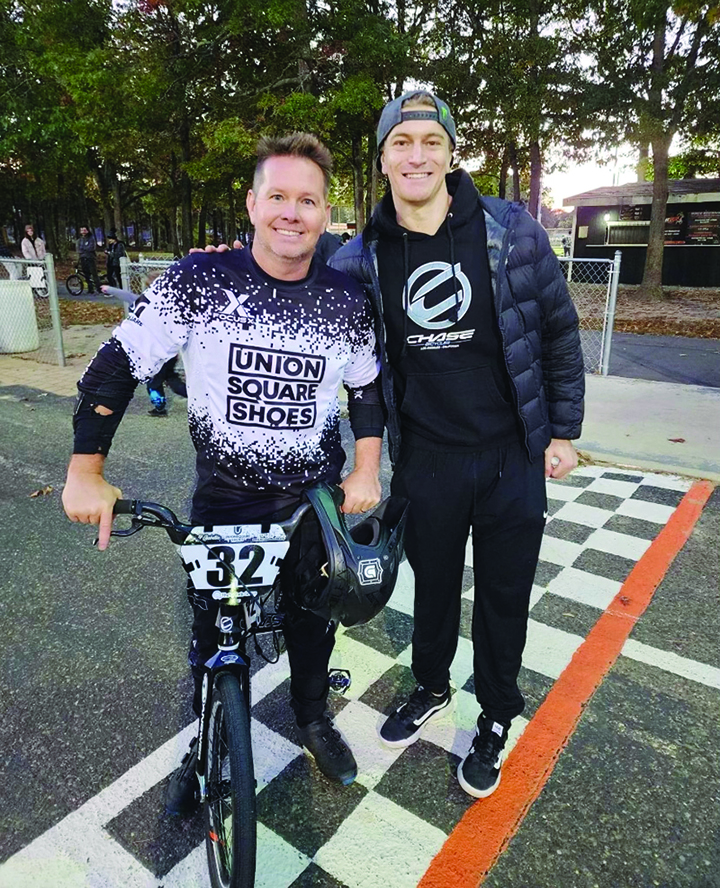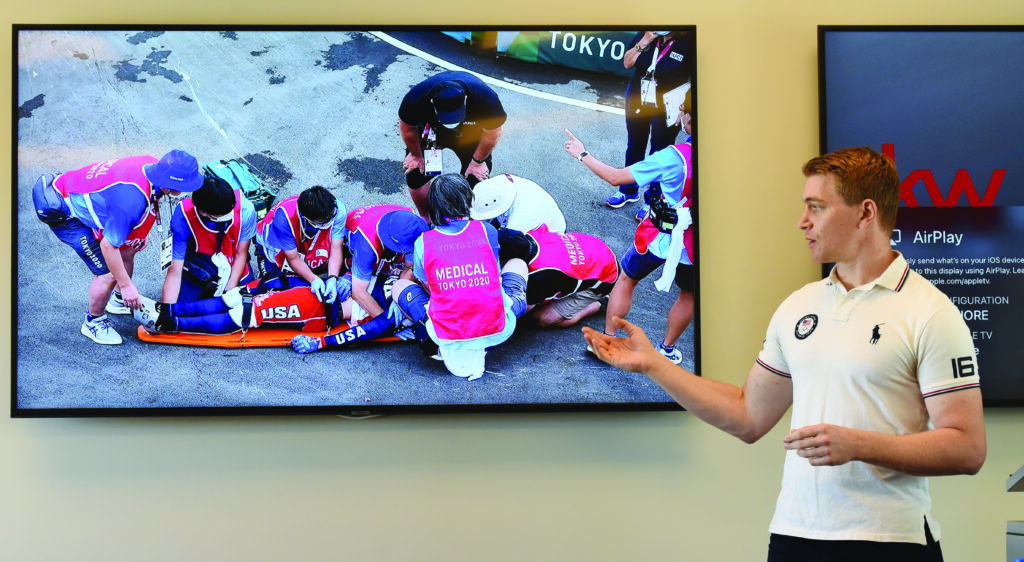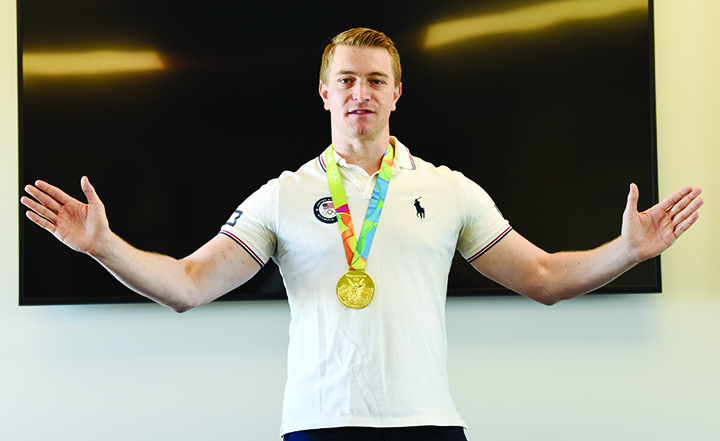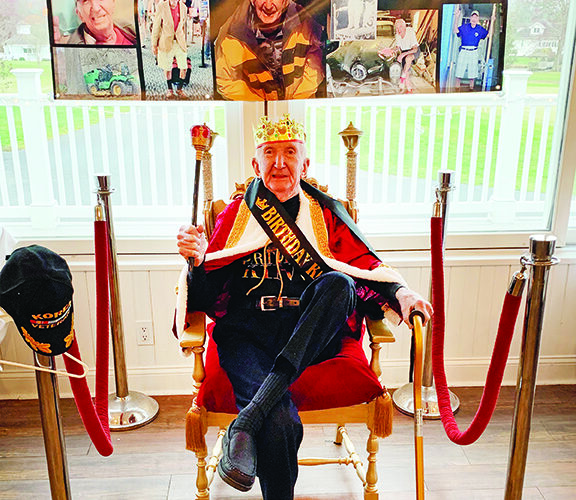Connor Fields set goal as a teen, worked tirelessly, learned from failure, overcame injury, nearly died
OCEAN CITY — BMX racer Connor Fields announced his retirement in August. The Olympic champion just turned 30 years old in September.
He has packed a lot into his life so far.
Fields set a goal as a young teenager and began working furiously and tirelessly to reach it. He became a Team USA competitor at the 2012 London Summer Olympics at age 19, overcame an injury to be a gold medal winner at the Summer Olympics in Rio de Janiero four years later … and nearly died competing at the 2020 Summer Olympics in Japan.
Jeff Quintin, owner of The Quintin Group at Keller Williams Realty in Ocean City, has his own passion for BMX racing. He raced until he was 17 before getting back into the sport a year and a half ago. Now he competes in the expert division in the 46-to-50 age group.

Jeff Quintin, left, owner of The Quintin Group at Keller Williams Realty in Ocean City, poses with BMX gold medalist Connor Fields at the BMX track in Egg Harbor Township. Quintin raced as a teen and now competes in the expert division 46-50 age group.
Much of Quintin’s adult life has been building The Quintin Group into a multi-state power. He invited Fields for a motivational talk to his team in late October at his office at the corner of Ninth Street and Bay Avenue.
Fields explained what it takes to set a major goal, what it takes to achieve it and how to have perspective in life. His nearly hour-long talk kept his audience in rapt attention.
As a gold medalist, he used GOLD as an acronym to explain what it takes — Goal, Overcome, Learning, Determination — to achieve major goals in life.
Those who aspire to win that gold have to focus in on it every single day, he said. It is the accumulation of years of hard work to reach “your absolute peak of what you are capable of.”
“There is a reason why the slogan is ‘Go for the gold,’ not ‘try to get fifth place.’ Going for the gold means you are committed, you are ready and willing to give a 100 percent effort to achieve what you have set as your gold medal.”
A dream begins, a goal is set
Fields was 12 in 2005 when the Olympic Committee voted to put BMX — bicycle motocross — into the 2008 Summer Olympics in Beijing, China.
The sport was invented in southern California in the 1960s by kids who would make homemade race tracks out of dirt, grab their friends and bikes and have races. A lot has changed, he said, but a few things haven’t: starting line, jumps, turns, a finish line and the first person across it winning.
Modern day BMX consists of starting hills three stories tall, speeds that reach up to 50 mph and jumps that can reach 50 feet in length. Eight racers at a time battle around the track.
“Still, the first person across the finish line wins,” he said.
He played different sports when he was a kid but knew he found his passion when he started racing BMX. He stayed up all night to watch the first Olympic BMX races as Team USA brought home three medals, but none of them gold.
“Something came over me. I wanted to do that. Really bad,” he said. He grabbed a Sharpie, went into his parents’ garage and wrote on the wall: “I will win a world championship and one day become Olympic champion.”
“Once I got off being grounded, for writing on my parents’ garage wall with a Sharpie, I was left with a message that I was going to have to look at every single day.
“That’s a pretty big thing to identify at 15.”
He had no idea what it would take and he wasn’t even ranked as the best 15-year-old on the West Coast, “but I knew that is what I wanted. That became my goal.”
Every decision matters
To get to the goal requires surrounding yourself with supportive people, but another aspect is that “every single decision you make matters. Every single decision can affect you.”
That includes putting yourself in proper situations and as a professional athlete being “on the clock 24/7/365.” Deciding to get a fast-food meal instead of a proper meal, or going out on a Friday night can affect recovery and sleep cycles for days.
He didn’t discover a magical secret to get to his goal. It meant getting up before school to work out, practicing after school, not hanging out with friends and just studying to become the best BMX racer.
“That is the type of commitment that has to be made when you want to achieve a major goal,” he said. “Those are types of sacrifices you are willing to make.”
In 2009, when he turned 16, he was able to compete in the BMX World Cups and to qualify for the Olympics. He was nervous lining up against his heroes at his first BMX World Cup, but he made it to the finals, where he finished third. He set a record that still stands for youngest rider to ever stand on the podium at a BMX World Cup event.
At that moment he realized he may actually be able to reach his goal.
In 2011, he won his first BMX World Cup and backed it up with another World Cup win in 2012.
He qualified for the London Olympics in 2012 and would be the youngest rider competing in event.
Blowing it at the London Olympics
In London in 2012, he won all of his heats and all of his semifinals. He made it to the finals as the No. 1 seed in pole position.
“Everyone has you picked to win … and you blow it. You choke,” he said.
With billions of people watching around the globe, he finished seventh of the eight finalists.
There are four things an Olympic athlete can take home: a gold medal, silver medal, bronze medal … “or a shiny new participation certificate.”
Of 32 who competed in BMX, 29 went home with the certificate. He was one of them.
After years of training, buildup and hype, its comes down to one race, one moment, he said. “And it didn’t have a happy ending.”
He was perfect in six races, but completely blew it in the finals, the one that mattered.
With the loss came depression and self-doubt.
“When I came home, I couldn’t bear to look at what I had written on that wall.”
He wondered if it wasn’t meant to be. The toughest thing was knowing he didn’t do his best.
A decade later, looking back, he can be proud because he had to overcome his failure.
“Eventually we’re all going to lose or fail at something and we’ll have to overcome that loss,” he said, adding the L in GOLD stands for learning.
Learning from losses is important for athletes and in life. Failures can offer important lessons.
In 2013, he left his parents’ home and ordered a 10-foot by 2-foot panoramic view of Rio de Janiero, the site of the 2016 Summer Olympics. Every day of the next four years he looked at it, the goal he was working toward.
Accident nearly derails his dream
Fields explained there are three ways to make the three spots on Team USA. One is to be the highest-ranked rider in the BMX circuit, the other is to win the Olympic trials and third is to be the coaches’ choice.
He started 2016 winning multiple events, taking the national championship and building points as the No. 1 ranked American.
“Every time I hopped on that bike I felt like I could do no wrong.”
Something did go wrong. Badly wrong.
Less than five months before the Olympics, getting ready for the World Cup, he misjudged the distance on a jump, smashed into the ground at 35 mph and broke his wrist. After eight painstaking days waiting for the best surgeon and a six-hour operation, he got the bad news. The break was much worse than anticipated.
With five screws in his wrist, a piece of bone grafted to help his nearly destroyed scaphoid bone recover, he learned the best-case scenario for recovery was four months, but more likely six months.
There “was a chance, however slim” he would be able to race at Olympics, he said.
He wondered not only if he would recover in time, but even if he did, would the coaches pick him for the team since he couldn’t win the trials or the points to be the No. 1ranked rider.
He was “an absolute wreck” over the next few months.
After the Olympic Trials, he was told he needed proof he could ride. X-rays showed he wasn’t fully healed but was able to ride. The catch was if he fell on his hand, even lightly, he risked permanent damage. The doctor couldn’t legally clear him and left the decision up to him.
“I hopped back on that bike way sooner than I should have just a couple of days before I had to prove to that Olympic Team I was the right decision.”
This is where the D in GOLD comes in: Determination.
He had overcome so much — injuries, depression, failures — and had put in years of hard work.
“Determination is the glue that holds everything together. I was willing to do pretty much anything to achieve that goal,” he said.
He was named to the team and had eight weeks “and had to make them count.”
“There was no greater feeling than being 100 percent committed and absolutely hell-bent on going after that goal. Every single day had the intensity of the Olympics themselves.”
Facing nerves in Rio and gold medal race
He said the experience in Rio was “pretty horrible. You have knots in your stomach for a week. You have trouble eating for a week. Sleep? Good luck. You’re definitely not getting much of that.”
The night before the first of two days of racing — the quarterfinals the first day and the semifinals and finals the next — he couldn’t eat his proper meal. His coach told him he had to eat something. He had two slices of pepperoni pizza and a Pop Tart.
Competition is a two-day format. If you get through quarterfinals on the first day, semifinals and finals would be second day.
He advanced to the semifinals.
When he woke up on the second day, he said, he felt a strange calmness.
“Today was the day I had prepared for so thoroughly for the past eight years. Today was the day I lived in my head a thousand times.”
He had four races ahead of him — three semifinals and the finals if he advanced.
He was in the more difficult semifinal stacked with the world’s best eight riders. The top four would move on. He finished second.
In the second semifinal, he finished second again. In the third race, he needed a sixth place finish or better to advance. “Basically don’t crash and you’re in,” he said.
He had a fantastic start, but was hit from behind and went down awkwardly.
“If that same situation had happened a thousand times, I might have only been able to save it once. By far, it was the best save of my entire career. On this day I was so focused, I was so locked into every moment, I was able to save it and finish in sixth place,” Fields said.
He made it to the final but because starting position was based on the previous race, he started on the outside of the grid, known as the worst place to start, and opposite of the pole position he started at the London Olympics.
As he got into position, his coach approached and said, “Connor, do you remember London? Do you remember how that felt every day? This is your chance to make it right. Go get it.”
Again, with the hopes of the country resting on him, his whole career came down to that final race.
“The next 34.642 seconds would unfold in a way that even Hollywood couldn’t have scripted.”
He had the best start of his life, shot into the lead but was beaten to the first corner by another rider. He realized it was the other American in the field. Now he was faced with the hardest scenario: he was in Olympic silver medal position with his teammate, a friend he had grown up with since he was 10, in the gold medal position.
“What do I do? Do I attempt to pass my teammate and risk crashing myself out of the race? Crashing him out of the race? Or the absolute worst case scenario, crashing us both out of the race? And now the headline of The New York Times is ‘Fields blows a U.S. gold-silver sweep?’
Or do I just sit back and play for the silver?”
He didn’t have to ponder the answer for a split second.
“In that moment, I didn’t blink. I didn’t care who that was. It could have been my own mother out there. I did not go through broken bones, I did not go through depression, and I did not go through a decade of work, my coaches, my parents, supporters didn’t give me all of their best for me to get this moment just to settle, even if settling meant settling for a silver medal.”
He attacked, passed his teammate without affecting his race or his own, crossed the finish line and won gold.
“Imagine crossing the finish line and becoming Olympic champion … of stepping onto the podium as they raised the American flag and played the National Anthem.”
He heard his father in the stands, the guy who drove him to practice every day when he was a kid, “bawling his eyes out.”
A gold medal that is not all gold
Between the race and medal ceremony, he went over to the fence separating the spectators from the competitors to talk to his father.
“You did it,” his father told him. “You painted it on the wall and you made it come true.”
Fields said a little known fact is that 90 percent of a gold medal is silver covered with six grams of gold.
“It’s a perfect representation,” he said. “On the outside is gold, that is what you see. The perfect game, the perfect execution. But you don’t see beneath that. The process of setting the goals, the obstacles along the way, the failures. And all the lessons that had to be learned. You don’t see the determination it takes to stick with the goal all those years.”
Almost dying at Tokyo Olympics
After taking some time off, he decided he would try to repeat as champion at the 2020 Summer Olympics in Tokyo. Like other Olympic athletes, he had to add an extra year of training because COVID-19 delayed the games until 2021.
He said he never lost dedication and was in the best shape of his life when he boarded the plane to Japan.
Fields smoked the competition on the first day and entered the second day as the No. 1 seed, everything on track for his second gold medal.
On the second day it was pouring rain. He went over to ask his coach if there would be a rain delay.
“And then I woke up. Alone. In a hospital bed, covered in bandages. Scared. Confused. With no idea what was going on and not a single person who spoke English to tell him what was happening.”
To fill in the details, he had to find out everything second-hand because his memory “had a five-day gap.”
The rain had subsided. He finished third in the first semifinal and was first in the second semifinal. He had pretty much guaranteed himself a spot in the finals, just like in Rio.
In the third semifinal, he collided with another rider and went down hard.
He was unconscious for 20 minutes. “As I lay there on the track, I stopped breathing. The entire event was halted as medics first rushed to stabilize me, create an airway to make sure I was going to live.” Then they loaded him onto a body board and into an ambulance.

“I suffered one of the worst accidents in the history of the Olympic Games. Torn ligaments in my shoulder, torn biceps, broken ribs, collapsed lung, and the big one, traumatic brain injury. I had bleeding in four different parts of my brain. I had injuries to my frontal lobe, my parietal lobe, my corpus callosum and my brain stem.”
When he was on the track bleeding, “the initial concern was if I was going to survive. Once stabilized and in a coma for several days, it was even if I was going to remember who I was when I woke up.”
A few hours earlier, his biggest fear was returning home with another Olympic participation medal. When he woke up in the hospital, he was still himself, with his memory intact except for those days around the accident.
Then he began his rehabilitation process “to get my life back.”
Two weeks after being in the Olympics, he was relearning how to balance, repassing his driver’s test and going to speech classes to relearn how to talk properly.
He attacked the rehabilitation process as hard as he attacked his drive for Olympic gold.
“The same mindset that got me to the Olympics was the same mindset I used with this. … These were just new goals, new challenges I would have to overcome.”
With an amazing team around him, his recovery, he said, “was miraculous.”
“I am thankful I can stand here today and share my story. It shouldn’t take a near-death experience to put that type of perspective back into your life.”
He told The Quintin Group to go after their goals, “but when you do fail, don’t ever lose perspective of what’s truly important in life.”
“Life is defined by how much you are willing to overcome.”
By DAVID NAHAN/Sentinel staff



